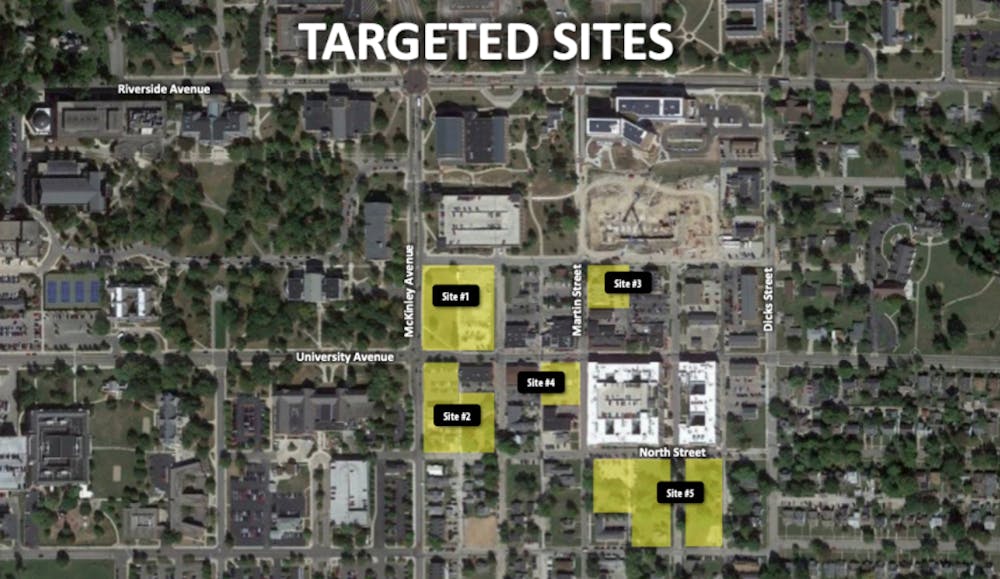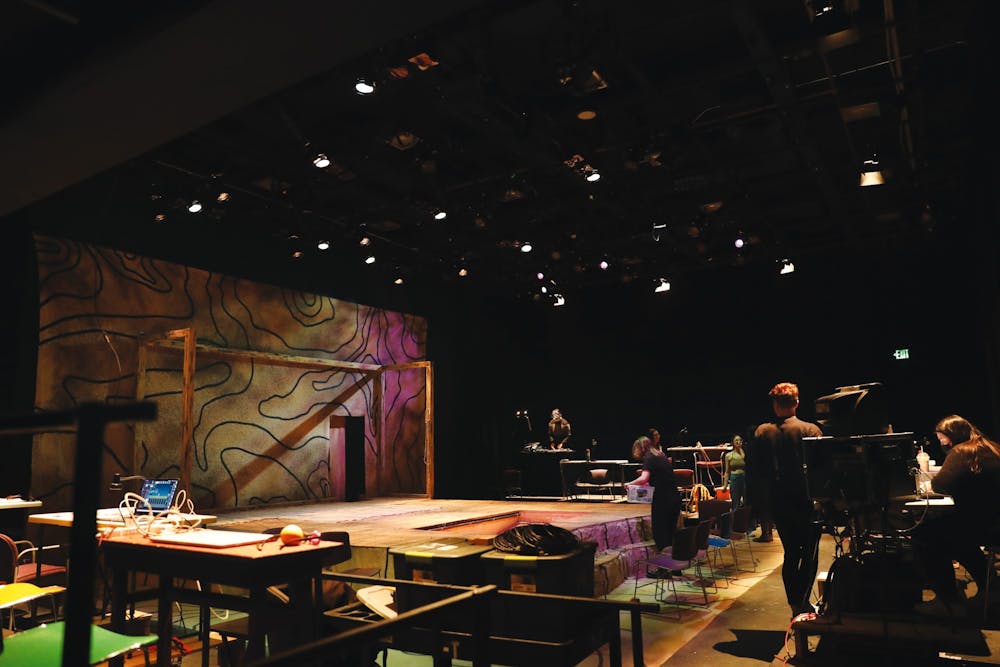Bill Jenkins, chair of the Ball State Department of Theatre and Dance, said he has waited 20 years for his department to obtain more performance space to help students grow in their skills and experiences.
At the Board of Trustees meeting March 25, those hopes were realized with the board’s approval of a plan to build arts-themed businesses in the Village using property it already owns. The anchor business will be a performing arts center for the Department of Theatre and Dance.
“We’re going to have the resources and facilities to match the quality of our students that we've never been able to even attract, or equivalent to the top-notch students I’ve had — we’ll just be able to have more of them,” Jenkins said. “It’s going to help solidify and unite our programs, which have been all over campus for so long … I think it is going to be an extraordinary way for us to contribute to the Ball State community as a whole.”
Jennifer Blackmer, professor of theatre and playwriting, said plans for the performing arts center were announced to faculty in the Department of Theatre and Dance a few days before the Board of Trustees meeting. She said she knew the announcement would be important because a department-wide email asked faculty to cancel or pause classes held during that time.
Blackmer has worked in the department for 19 years, directing shows in both Strother Theatre and University Theatre. She said the issues in those spaces have been “obvious for two decades now.”
Blackmer said she specifically remembers watching a rehearsal for a show she was directing in University Theatre in 2005 when a piece of acoustic tile and plaster fell from the ceiling onto her head. It is because of issues like that, Blackmer said, that the announcement meant so much to the Department of Theatre and Dance.
“To get that kind of news … and we have really been advocating that in order to keep doing the work that we’re doing, we really need facilities that are supportive of that,” Blackmer said.
Blackmer said, of the estimated 12-14 Ball State shows she has directed, students have made the best of their circumstances in Ball State’s current performing spaces. She gave examples of students using boomboxes for sound when audio wasn’t working or strategically blocking choreography in smaller spaces.
“Our students, in particular, have expressed just tremendous creativity over the years in working within the parameters that they've had with these spaces,” she said. “But there comes a point when there's diminishing returns on that, and I think we've kind of reached that point.”
Blackmer said the new performing arts center will offer updated resources students are more likely to see when they enter professional jobs, particularly for theatre design and technology students.
Even though current students likely won’t be able to use the performing arts center space, as it’s set to open in fall 2025, Blackmer said she’s told her current students their work is the reason the department is getting updated spaces.
“It’s so important for them to know that the reason this is happening for the department is because of their commitment over the years,” she said. “I’ve tried throughout this entire rehearsal process, as soon as the announcement happened, to let the students know that, ‘I know it’s sad you won’t be here for this part of the department’s journey, but at the same time, it’s happening because of you.’”

Ball State University owns five properties surrounding the Village in Muncie. The Board of Trustees approved a plan to construct a performing arts center, hotel, restaurants, apartments and activity center at its March 25 meeting. The unifying theme for the project is improving arts and culture in Muncie. Ball State Marketing and Communications, Photo Provided
Nicole Tate, freshman theatre education major, pinpointed the Cave Theatre in the Arts and Communication Building as an example for needed space. She said black box theaters are usually a full box space, but performances in the Cave Theatre have to navigate around office space. Tate said she is excited for directing majors to have more space for productions.
Because Tate is new to the Department of Theatre and Dance, she said she doesn’t have a clear picture of how the new performing arts center will affect students.
“I'm definitely excited about it, but I don't even know the department well enough to say it is going to be a big change,” Tate said. “I feel like everything is a big change for me coming in this year. I know for seniors and faculty, this is like a huge deal, and it will be in the future, too.”
The new spaces, Tate said, will give her and other future alumni a reason to return to campus after graduation.
“I hope that, as an alum, that I would come back and see shows here because of how much it will have affected me,” Tate said. “I think it's definitely exciting news they can use for prospective theater students … because they'll actually get to experience it.”
Ball State President Geoffrey Mearns said at the Board of Trustees meeting the university will transform five sites in the Village into a performing arts center, 100-room hotel, apartments and restaurants over the next several years. He hopes construction will begin next year.
“[We are] not simply attracting students, not simply attracting faculty and staff, but attracting people of all ages and all interests to come to the Village,” Mearns said. “This is an ambitious plan, but Fairmount has done it before.”
Fairmount Properties, a development firm that has worked on renovation projects of other college towns, including Rochester, New York, and Kent, Ohio, was selected as the university’s partner after a two-year review process of different proposals, Mearns said.
“Fairmount Properties is excited to be partnering with Ball State University,” said Randy Ruttenberg, founder and principal of Fairmount Properties, in a March 25 press release. “We met with various community stakeholders over the past year, and we connected with many current merchants and property owners in the Village. We will use a district-wide approach to elevate the Village, and we look forward to collaborating with existing merchants and future tenants to do so.”
Ruttenberg said Fairmount Properties looked at each site the university owned to propose a plan to create “synergy among all five of those sites [so] that they together would be able to draw not only the student population, but the broader population within the community and the region.”
“President Mearns has been very focused on making this certainly about the community, but he's got students in his heart first, and we want to make sure that this that this is a village where students can come here during a campus visit and say, ‘Wow, I really want to go here,” Ruttenberg said.
Diego Sanchez-Galvan, freshman acting major, said the new additions to the Village will provide performing arts students with more opportunities to be creative.
“I think new spaces for performances would be very beneficial and a great way for us to share even more art and knowledge,” Sanchez-Galvan said.
Sanchez-Galvan said that he “wish[es] it would have happened sooner, but it’s good that it’s [happening] now.”

Freshman acting major Diego Sanchez-Galvan poses for a photo April 4 in front of University Theatre. Sanchez-Galvan recently performed in “The Curious Incident of the Dog in the Night-Time” at the theater. Rylan Capper, DN
Maya Galipeau, sophomore musical theatre major, said the performing arts center can help bring more interested students to Ball State, as well as promote business for Village shops. She said, “all the fine arts programs at Ball State would benefit from [the new performing arts center].”
Galipeau gave examples of some struggles currently faced by students rehearsing for shows in University Theatre and Strother Theatre.
“The sound bleed between Strother and University Theatre is enough to ruin rehearsals and show schedules,” Galipeau said.
The university will finance the projects, for which Mearns said he expects to generate $100 million in private investment. A university spokesperson said the performing arts center could cost up to $40 million, which will be funded by the university and gifts from Ball State graduates and friends.
“We are confident that strategically co-locating a performing arts center, arts and culture-themed restaurants, hotel and retail space will provide the blend of amenities that will entice activity in the Village,” said Jim Lowe, associate vice president for facilities planning and management, in a March 31 statement. “This holistic approach will be a major step towards creating excitement that will sustain economic growth and community support.”
Chris Bolender, production stage manager and stage management instructor, coordinates scheduling and production elements for all Department of Theatre and Dance productions. He said when he heard the announcement for the performing arts center, his reaction was “enthusiastic hope and anticipation, tempered with the knowledge that we have a long way to go to get there.”
While the university still needs to raise money in support of the performing arts center, Bolender said faculty hope the state-of-the-art center will help students gain experience as they prepare for their careers.
“We’ve all had our imaginations launched into the stratosphere of possibility,” he said. “I’m confident that a new facility will enable us to offer performance and production experiences that rises to the excellence of our students. Our current facilities, while we love them, sometimes present challenges to being able to offer everything the students need to be fully supported.”
The Department of Theatre and Dance currently hosts about 20 performances across campus during the fall and spring semesters each year. Because of additional space and opening its doors to community performances, the new performing arts center is expected to host more than 160 annual performances, as well as summer music and theater workshops.
Ruttenberg said at the March 25 meeting he looks forward to Fairmount Properties helping to unite and expand Ball State’s campus toward further community development and “helping everybody in the Village to be successful.”
Contact Grace McCormick with comments at grmccormick@bsu.edu or on Twitter @graceMc564. Contact Mackenzie Rupp with comments at msrupp@bsu.edu or on Twitter @kenzieer18. Contact Daniel Kehn with comments at daniel.kehn@bsu.edu or on Twitter @daniel_kehn.





